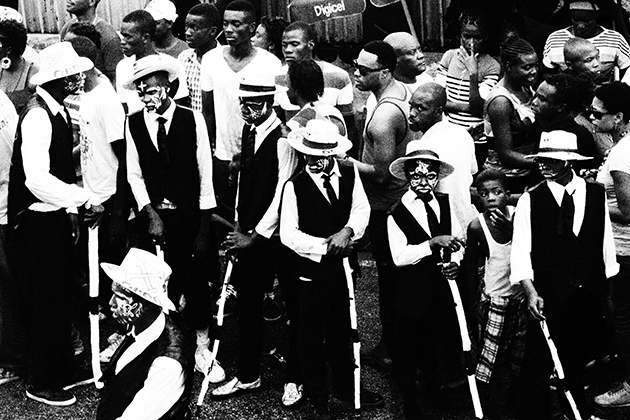Carnival in Jacmel
Despite lingering effects from a 2010 earthquake, Haiti still throws a good party
In 325 A.D., Constantine’s Nicene Council decreed a date for commemorating Jesus’ rise and declared that during its lead-up, no meat should pass the faithful’s lips. Constantine wasn’t issuing an invitation to party. But just as Easter’s date was tied to pre-Christian tradition — its Sunday corresponds with the first full moon after the Equinox — the faithful’s old ways died hard. In pagan Venice and Rome, citizens marked their saturnal fetes by wearing masks and getting drunk; now, on Lent’s eve, they did the same. Their new tradition spread quickly, becoming ingrained across Europe.
And then Columbus crossed the sea. When the French and Spanish and Portuguese sent men and boats to make their empires in the Indies, they brought carnival with them. It was in this New World’s plantation colonies, whose owners also brought 10 million Africans here, to feed old Europe’s love for sugar, where carnival found its great modern forms.
Amid lives of brutal privation, carnival became a lifeline. The Americas’ slaves used Shrove Tuesday’s license, each year, as a permit for “turnabout” and play — a time to dress up as their masters and to dance; to nurture their ancestors’ symbols and sounds; to transform those traditions by making them new. This is how it went in Brazil, with its samba and candomblé. It’s also how it went in Louisiana, with its jazz and jambalaya, and the Mardi Gras Indians who, after Hurricane Katrina drowned New Orleans, gave its people their refrain: “We won’t bow down.” And it’s how it went, too, and still does, in Haiti, which was once the most lucrative and brutal slave colony of all.
Last week, I attended the carnival kick-off in the beautiful southern city of Jacmel, whose crumbling grandeur is reminiscent of Havana. This was once the wealthiest coffee port in the world: its French owners built stately homes in the eighteenth century with fortunes made from their slaves’ backs. When those slaves rose up to seize their freedom, they birthed, in one swoop, both Haiti and the torrid history by which its people — saddled by debt and shunned for half a century by the only other sovereign state in the hemisphere, the United States — became its poorest.
In the revolution’s wake, Jacmel’s overclass fled for New Orleans. But the town became a mecca for art: for painting, for handicrafts in cast iron and wood, and for the rara bands who during Lent bang out polyrhythmic poems on guiro gourds and banbou horns. But what Jacmel is best known for, especially at carnival time, are the magnificent masks and creatures local artisans craft in papier-mâché. Their creations — dragons, pigs, politicians, cars — embody much more than whimsy. Each one carries symbolic weight that resonates with Haiti’s past. When a troupe of dark-colored pigs shuffles past, they represent cochon créole, the hearty black beasts who were killed off en masse by U.S. aid workers after a swine-flu outbreak in the early 1980s. This is a folk history whose annals every Haitian peasant, literate or not, knows deeply.
Today, four years after a massive earthquake made Haiti’s name synonymous once more with suffering, the country has made great strides. It has also been beset by cochon créole–type setbacks. In the capital, half a million people are still quartered in tents; their makeshift homes calcifying into permanent slums. But there has also been a palpable lessening, many say, of quotidian tension. President Michel Martelly — once known as the carnival singer “Sweet Mickey” — is the first head of state in Haiti’s history to assume power peacefully from an incumbent opposition leader. His administration has been dogged by corruption and has sparked outrage by delaying new elections, but at carnival these frustrations found peaceable expression.
On Jacmel’s teeming main street, I swam through the crowd behind a troupe of costumed revelers who scraped big shovels on the pavement, pushing wheelbarrows as they went: the work of building Haiti, whoever’s in charge, continues apace. In the central square, we bounced along to the kinetic sounds of RAM — the leading rasin group, whose 2014 carnival tune “Se Pa Sa’w Te Di” (That’s Not What You Said), over layers of “vodou rock,” decries Martelly’s defects. Joining RAM on stage was Arcade Fire, the Canadian alt-rock superstars whose frontwoman, Régine Chassagne, has roots here.
For years, Arcade Fire has supported the nonprofit group Partners in Health and other outfits devoted to helping Haitian institutions build the country; the band also credits a trip to Jacmel carnival, a couple years back, with inspiring their latest hit record, Reflektor. “It’s hard to be surrounded by such a deep music experience,” lead singer Win Butler explained, as rara bands jangled past, “and not want to participate in some way.”
Haiti’s government hopes many more blans agree. The country’s leaders, notably the impressive young tourism minister, Stépanie Villedrouin, see attracting visitors as key to its development, and the charms of carnival as the heart of those aims. Their efforts haven’t been without controversy, as recent protests against new airports and resort projects attest: tourism can as easily harm locals’ environs and livelihoods as improve them.
But walking Jacmel’s carnival last week, it was impossible not to be struck by a quality too rarely noted in a land so tied to abjection. “Carnival is a celebration of history,” the Haitian-American writer Edwidge Danticat has said of Jacmel, “and this is a place of joy.” It’s still true.




